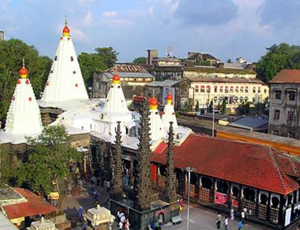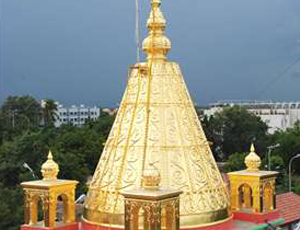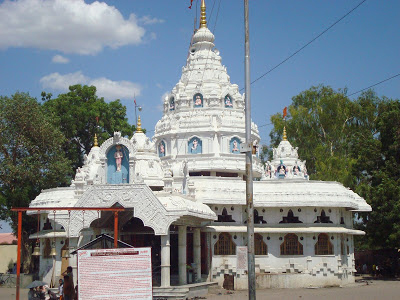3 days trip to Shirdi From Coimbatore
Shirdi is best known as home of the popular Guru Shirdi Sai Baba. On any given day around 25,000 devotees come for darshan. On holidays the number reaches about half a million people.This package includes visit to Ellora caves and two Jyothirlings. These are the best tourist spots in India.
Package Includes
Accommodation
Food
Cab
Sthalapuranam
Itinerary Temples
- Shirdi VIP Samadhi mandir
- Gurusthan
- Baba's Chavadi
- Dwarkamai Masjid
- Grishneshwar Temple
- Ellora Cave Temples
- Bhadra Maruti Temple
- Dattatreya Temple
- Shani Maharaj Temple
- Tryambakeswar Temple.
Full Itinerary
Evening
VIP Samadhi Mandhir
- The Sai Baba Temple of Shirdi is also known as Sai Mandir or Samadhi mandir.
- The Samadhi Temple, which is actually Sai Baba’s shrine.
- The Sai Baba temple complex has four gates and the queues for darshan into the Samadhi temple begins only at gates 2 & 3.The Samadhi Temple, which is actually Sai Baba’s shrine.
- Thursdays are considered very auspicious among devotees for a visit to the temple as it is considered Sai Baba’s holy day.
- At Shirdi, the day starts very early with the daily morning aarti which is held every day at 5:30 am followed the ‘holy bath’ of Sai Baba.
- The three main festivals are celebrated in Shirdi. They are Ramnavami (March/April), Guru Purnima (July),and Vijayadashami (September).
- The Samadhi Mandir remains open all night during one of these days
Evening
Gurusthan
- Gurusthan means “place of the Guru”.
- It is both where Baba spent most of his time when he first came to Shirdi, and also where, according to Baba, the tomb of his own Guru is located by the neem tree.
- Gurusthan is therefore one of the most important places in Shirdi.
- There is a small shrine in Gurusthan. On a elevated platform of this shrine a big portrait of Lord Sai Baba is placed. On the side is a marble statue of Baba. In front of the portrait is a Shivling and the Nandi.
- Photos of twelve Jyotirlingas are also kept in the temple.
- From underneath the NEEM tree there is an underground tunnel or passage leading to the place of Dwarkamai.
Evening
Baba’s Chavadi
- Baba’s Chavadi is the place where Sai Baba used to sleep here every alternate day.
- Chavadi is also very significant to Sai devotees as it played a major role in the inception of formal worship of Baba.
- Once Baba started sleeping at Chavadi, the custom arose of offering regular arati to him on his arrival from the mosque.
- The Chavadi is divided into two parts. One part of the Chavadi has a large portrait of Baba along with a wooden bed and a white chair belonging to him. There is a cottage of Abdul Baba, an ardent devotee of Shri Sai Baba, in front of the Chavadi.
- This mandir was visited by Baba for the sat-sang with Devidas, a Balyogi, who lived at the Mandir ten to twelve years before Baba arrived.
- Every Thursday the Palakhi from DwarkaMai arrives here.
- Baba's Photograph, his Paduka (slippers), and Satka are kept in the Palakhi.
Evening
Dwarakamai Masjid
- Dwarkamai is situated on the right side of the entrance of Samadhi Mandir.
- Here Sai Baba solved problems of the people, cured their sickness and worries
- The first level of Dwarkamai has a portrait of Baba and a big stone on which Baba used to sit. This level has two rooms. One contains the chariot and the second a palkhi.
- The second level of Dwarkamai has a square stool made of stone,which Baba used for taking a bath.
- The main attraction of this place is the oil painting of Shri Sai Baba sitting in a carved wooden shrine.
- In Dwarkamai ,the dhuni's (ashes) are burning since Sai Baba's time.Sai Baba distributing the holy 'Udi' - the panacea for all troubles - to his bhaktas.
- 'Udi' is the ash that drops from the holy fire kindled by baba a hundred years ago.
- Even now the sick and the unhappy are healed if they take this divine medicine with faith.
Morning
Grishneshwar Jyothirling
- Grishneshwar (Ghushmeshwar)Temple is an ancient pilgrimage site revered as the abode of one of the 12 Jyotirlinga manifestation of Lord Shiva.
- The Grishneshwar Jyotirlinga shrine is located at a village called Verul.
- The temple is made up of Red stone and artistic . River Yelaganga flows here.
- The Jyotirling and the Goddess, Grishneshwari, both are seen in inside the Garbha gruham.
- Grishneswar is the 12th Jyotirling among the total 12 Dwadasha Jyotirlingas.
Morning
Ellora Cave Temples
- Ellora is one of the largest rock-cut monastery-temple caves complexes in the world.
- The site presents monuments and artwork of Buddhism, Hinduism and Jainism from the 600-1000 CE period.
- Cave 16 of Ellora features the largest single monolithic rock excavation in the world, the Kailasha temple, a chariot shaped monument dedicated to Shiva.
- The Kailasha temple excavation also presents the gods, goddesses and mythologies found in Vaishnavism, Shaktism and relief panels summarizing the two major Hindu Epics.
- The site features over 100 caves, of which 34 caves are open to public.
- These consist of 12 Buddhist (caves 1–12), 17 Hindu (caves 13–29) and 5 Jain (caves 30–34) caves.
- All Ellora monuments were built by Hindu dynasties, such as the Rashtrakuta dynasty who built some of the Hindu & Buddhist group of caves, and Yadav dynasty who built some of the Jain group of caves.
Morning
Bhadra Maruti Temple
- Bhadra Maruti Temple, Khuldabad is a temple dedicated to the Hindu deity Hanuman.
- The idol of Hanuman is portrayed in a reclining or sleeping posture.
- It is one of only three places where Hanuman is represented in a sleeping posture.
- According to folklore, in ancient times the Khuldabad was known as Bhadravati and the ruler was a noble king named Bhadrasena, who was an ardent devotee of Rama and used to sing songs in His praise. One day Hanumanji descended in the place, listening to the devotional songs sung in praise of Rama. He was mesmerized and without his knowledge took a reclining posture – called 'Bhava-samadhi' (Bhava samadhi is a yogic posture). King Bhadrasen, when he had finished his song, was astonished to find Hanuman in Samadhi before him. He requested Hanuman to reside there forever and bless his and Lord Rama's devotees.
- The Bhadra Maruti Temple is considered one of the tourist attractions and people gather in lakhs during auspicious occasions like Hanuman Jayanti and Ram Navami.
Evening
Dattatreyar Temple
- Dattatreya Temple is located at Ganganapur, Maharashtra.
- Dattatreya is a Hindu deity considered to be an avatar (incarnation) of the three Hindu gods Brahma, Vishnu, and Shiva, collectively known as Trimurti.
- The presiding deity is Dattatreya, an incarnation of Lord Vishnu Dattatreya.
- It is currently more like an 'Ashram'.
- Dattatreya Temple has a very small room divided into two by a wall. There are two doors, and in the inner portion, there are the images of Dattatreya and the 'Nirguna padukas'- a pair of sandals.There is a very small opening in the wall in the form a silver-plate framework, which allows pilgrims to have a glimpse of the image. Some feet away is a door in the dividing curtain, where inside the sanctuary are the Padukas. It is these Padukas that are the object of worship at this place.
- It is a symbol of the constant and eternal presence of Dattatreya in his form as Nrisimha Sarasvati.
Evening
Shani Maharaj Temple
- Shani Shingnapur is known for its popular temple of Shani, the Hindu god associated with the planet (graha) Saturn.
- Shingnapur is also famous for the fact that no house in the village has doors, only door frames.The bank has doors,but they will always remain open.
- The temple is believed to be a "jagrut devasthan" (lit. "alive temple"), meaning that a deity still resides in the temple icon.
- Villagers believe that god Shani punishes anyone attempting theft.
- The deity here is "Swayambhu" that is self emerged from earth in form of black, imposing stone.
- Lord Shani said there is no need for a roof as the whole sky is his roof and he preferred to be under open sky.
- The place is busiest on Saturdays.Shani Trayodasi is considered to be a favorite day for the lord. Similarly Saturday falling on 'Amavasya' is considered to be a favourite day for the Lord Shanaishwara and on that days devotees seeking his blessings throng this temple in thousands.
- Generally, the temple has 30–45,000 visitors a day, which swells to around three lakh (i.e. three hundred thousand) on amavasya (the no moon day), believed to be the most auspicious day to appease Shani.
Morning
Trimbakeshwar Jyothirling
- Tryambakeshwar is an ancient Hindu temple is dedicated to the god Shiva and is one of the twelve Jyotirlingas.
- The extraordinary feature of the Jyotirlinga located here is its three faces embodying Lord Brahma, Lord Vishnu and Lord Rudra.
- The Lingas are covered by a jeweled crown which is placed over the Gold Mask of Tridev (Brahma,Vishnu,Mahesh).
- The crown is displayed every Monday from 4-5 pm (Shiva).
- This temple is on top of the Neel mountain.
- Legend, All goddesses ('Matamba','Renuka','Mananmba') came here to see 'Parashuram' when he was performing penance (tapas). After his penance he requested all goddesses to stay there and the temple was formed for these goddesses.
- Breakfast for 2 persons.
- Transportation in AC Etios/Dzire cabs.
- Hotel accommodation based on type of package (standard/deluxe/premium) chosen. The price mentioned in this package is for family of two members sharing a single room. For extra person, please place a separate request with us.
- Room type is Standard A/C Room in 2 star hotel.
- Toll charges and driver's allowance.
- Upon booking confirmation, the sthalapuranam of temples mentioned in the itinerary will be sent through email.
- No extra charges for one child below the age of five.
- Package does not include lunch and dinner.
- The pickup and drop point information will be provided to the customer before booking. It is customer's responsibility to reach the pickup point of the trip at specified time. On request basis, GoSthala will arrange pickup from customers place of choice at any applicable nominal charges.
- All other expenses (temple entry ticket charges, parking charges, etc.) that are not specified in the package inclusions.
- Any loss/expenses incurred by unforeseen circumstances e.g. flight delays/cancellations, road blockages, vehicle breakdown, strikes, etc.
- Expense of personal nature such as laundry, etc.
- Any applicable service tax charges.
- Transportation provided will be as per itinerary only (not at disposal).
- The package price is indicative and based on seasonal demands the price is subject to change and will be informed prior booking.
- The package does not include guide services where not mentioned. Guide services can be availed from us at an additional cost.
- Payment method as follows: 25% payment on confirmation; 50% payment before starting the trip; Balance payment before end of the trip.
- 15% of package cost will be charged as penalty on canceling, 31 or more days before departure.
- 35% of package cost will be charged as penalty on cancellation between 22 to 30 days before departure.
- 50% of package cost will be charged as penalty on cancellation between 15 to 21 days before departure.
- 100% of package cost will be charged as penalty on cancelling, 15 days before departure.





